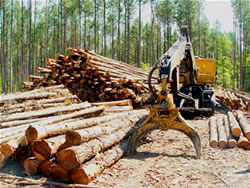Forests and Rangelands Success Story
Refuge Thins Pines to Reduce Fire Risk and Grow Bald Eagle Habitat
U.S. Fish and Wildlife Service, James River National Wildlife Refuge Complex, Virginia
National Fire Plan - Fuels Reduction
2010

Forest thinning project produces pulp wood piles, pole timber, and chip logs. Credit: Gerald Vickers, U.S. Fish and Wildlife Service.
The James River National Wildlife Refuge in Virginia gave some much-needed attention to one of the largest summer roosting areas for bald eagles east of the Mississippi River. During the fall, the refuge thinned forest to boost habitat quality and lessen the risk of losing the critical eagle territory to wildfire.
Service employees with specialized training and experience in forestry undertook the task of planning a project to commercially thin 450 acres of the refuge and to introduce prescribed burning to eliminate the remaining slash. The plan was designed to meet both fire management and biological objectives while minimizing ground disturbance and impacts to cultural resources in the area.
Following years of planning, the first step of the long-term project, which will ultimately restore and maintain ecological health of over 2,000 acres of forests at James River, began with thinning operations with the wood being used for a variety of products such as pine saw logs, pine and hardwood pulp and chips, and pine pilings. The area will next be prescribed burned to remove all of the remaining debris. After the project is completed, a reduction in fire risk and a healthy stand of trees suitable for nesting and roosting will result.
The Service acquired the land in 1991 after it had been managed for decades for commercial timber production. Since the area was last replanted, loblolly pine seedlings have densely regenerated creating intense competition among the trees limiting growth and the overall health of the timber resulting in compromised habitat for bald eagles. Historically, over 100 eagles have been observed roosting on the 4,200-acre refuge at one time. The concentration of vegetation also left the area vulnerable to wildfire. Unplanned fire in the timber would likely spread quickly and result in expensive suppression efforts with the potential for severe fire effects to the site.
In addition to eagles, songbirds, raptors and many other feathered creatures make their home in the upland hardwood forests, along the river and creeks, and near the tidal waters which make up the refuge.